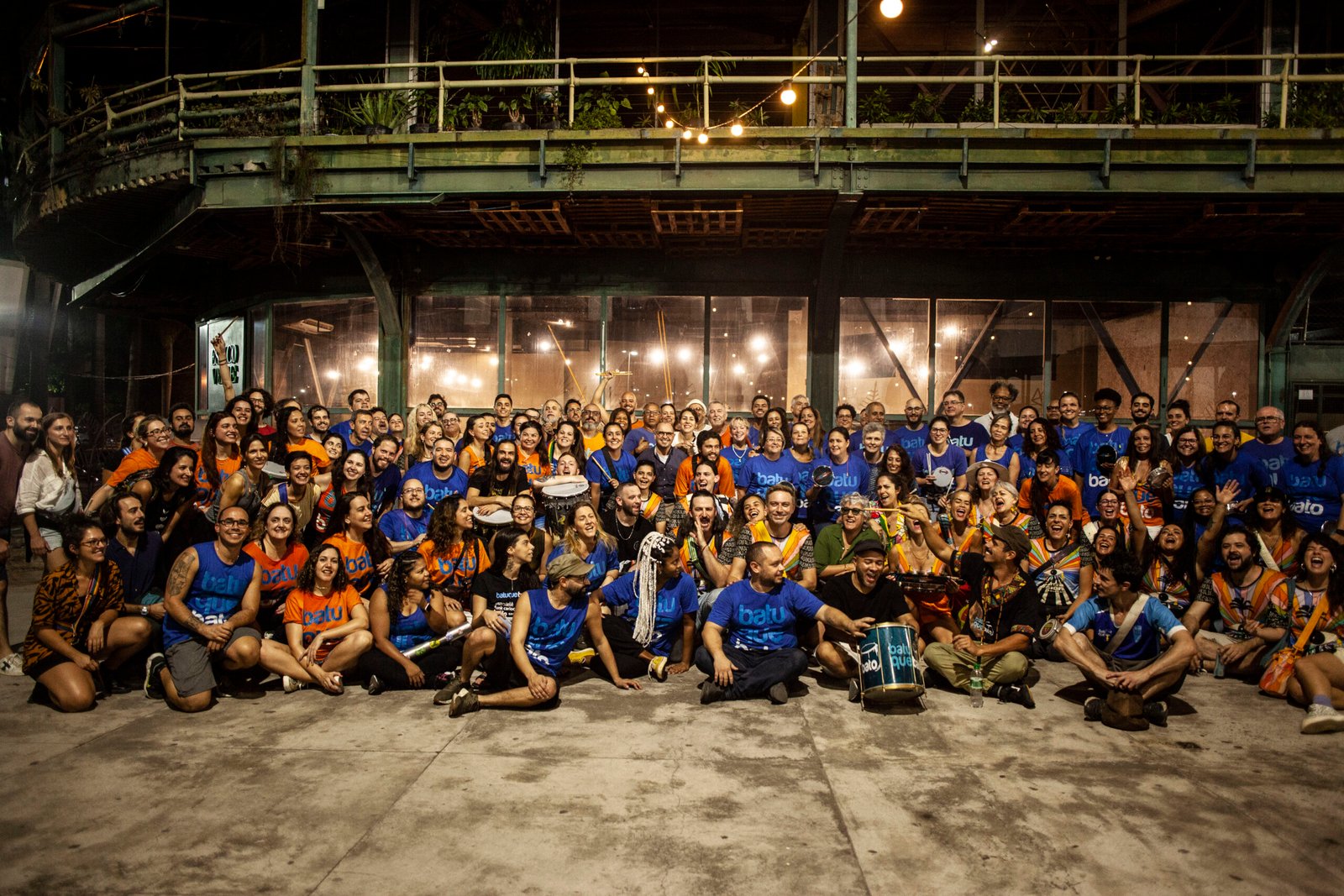What does it mean to be Brazilian in the U.S.? To me, it sometimes means searching for a heartbeat that feels like home. From the rhythms of samba to the sound of a tamborim on a Miami street, Brazilian music and culture become lifelines for connection and identity.
That search led me to a local street fair, where the unmistakable pulse of Afro-Brazilian percussion filled the air. Drawn like a compass to its source, I stumbled upon something extraordinary: a bloco brimming with energy, authenticity, and love for Brazil. But what truly surprised me was discovering that two of the people leading it weren’t Brazilian at all.
That was my introduction to SuOm Francis and Brian Potts, co-founders of Miamibloco—a Miami-based percussion collective that has become a vital force in South Florida’s Brazilian cultural landscape. From community rodas de samba to inclusive workshops and explosive stage performances, they’ve built a cultural movement that channels the soul of samba into the streets of Miami.
Now, with their eyes set on representing Miami at the 2026 World Cup, Miamibloco is ready to show the world what it means to become Brazilian at heart—through rhythm, community, and the joyful celebration of culture.

Here’s my conversation with SuOm—urban planner, artist, and one of the visionary forces behind this Miami-made bloco with Brazilian roots.
When and how did Brazil first come into your life? Can you share that moment when you first connected with Brazilian culture and music?
Brazilian music has a way of reaching every corner of the world, and for me, that connection began early. I grew up dancing lambada at birthday parties, watching Xou da Xuxa in the afternoons, and moving to the beats of Carrapicho at family gatherings. Later, as a teenager at Miami Beach Senior High, I met my first Brazilian friends, which deepened my interest and led me to start learning Portuguese.
But the real turning point came when I visited Rio de Janeiro. As a Raizal from the Caribbean archipelago of San Andrés, with deep Afro-diasporic roots, I felt a profound sense of homecoming. Brazil’s African heritage resonated deeply with me. Traditions like samba enredo, samba raiz, and tambor de crioula felt like extensions of my own story. That connection became even more powerful when I realized how Miami’s diversity mirrored this shared history.

You and Brian seem to be partners in both life and music. How does that dynamic play into the journey of Miamibloco?
Brian and I are definitely life partners, and building Miamibloco together has been such a beautiful journey. There’s something really powerful about doing meaningful community work alongside your favorite person. We bring different but complementary strengths—he has over 25 years of experience as a percussionist and educator, with deep expertise in Afro-Brazilian rhythms. My background is in urban planning and large-scale, culturally informed community development.
Together, we’ve built something that blends music with placemaking. For us, samba isn’t just art—it’s a tool to spark joy, foster belonging, and strengthen resilience in Miami.
The pandemic gave us time to reflect on what Miamibloco could be. We saw how isolation left people craving connection, and we realized samba could fill that void. Miamibloco isn’t just about rhythm; it’s about creating spaces where people can show up fully and feel like they belong—where everyone adds their rhythm to our collective heartbeat.
You’re not just playing music—you’ve built a community. What inspired the creation of Miamibloco, and how did it all begin?
As an urban planner, I saw Miamibloco as a chance to build something real for Miami—something rooted in joy and shared identity. Samba schools in Brazil are powerful examples of how culture can unite people across social and economic divides. I wanted to bring that same energy here.
In the beginning, it was all grassroots. We organized informal gatherings, scraped together funds, and bought drums directly from Brazil. We poured our own resources into the project while working other jobs to keep it going. But people kept showing up. The energy was magnetic.
Today, we’re a nonprofit organization serving thousands through workshops, performances, and cultural experiences. Miamibloco became a space where people from all backgrounds could come together, not just to play music—but to connect, heal, and celebrate.

How big is Miamibloco today? And how do programs like the workshops and the Academy contribute to that growth?
Right now, Miamibloco includes a community of about 80 ritmistas in our performance group, Bateria Saideira. We have four musas and our Rainha da Bateria, and every Monday, our public rehearsals draw an incredible crowd. Brian serves as mestre of the bateria, and we have six diretores who help lead, plus one community director who supports outreach and organization.
We also run the Bateria Academy, where we accept around 20 students per season. It’s a six-week intensive designed to teach the foundations of Miamibloco percussion and its cultural roots. Some of these students go on to audition for Bateria Saideira, while others join simply to keep learning and building friendships.
The workshops are magical. Some people come as a fun date, others bring their kids or co-workers. It’s a hands-on, joyful way to learn something new. And then there’s our Roda de Samba Raiz, the soul of it all—where we gather around the table, sing out loud, and remember what samba is really about: community, joy, and connection.
Miamibloco has connected you with incredible Brazilian artists. Can you share some memorable collaborations that have meant a lot to you?
Our annual show, Saideira Social, is where deep, intentional collaborations really happen. It’s hard to choose just a few names, honestly, because so many artists have helped shape this journey.
Within our own bateria, we have incredibly talented musicians—people who’ve mastered bass, guitar, piano, oboe, violin, voice, classical percussion—and now, they’re fully immersed in samba enredo with us. That alone is a gift.
Working with Rose Max and Ramatis Moraes has been a huge honor. They are timeless, embodying the true soul of Rio de Janeiro in their sound and presence. They’re absolute Miamibloco royalty.
Another cornerstone is Munir Hossn. Since our first Saideira Social, he’s brought an energy that is both wildly talented and deeply generous. We love performing with him, and we even have a track coming out together soon.
Gabriel Policarpo, one of the world’s repique masters, joined us in 2022. His group, BatuqueBato, is a foundational reference for how we teach. And now, for this year’s show on Memorial Day Weekend, we’re bringing back the mestres Gustavo and Guilherme Oliveira from Bateria Furiosa do Salgueiro. Alongside them, we’ll welcome Gilmar Gomes from Bahia and Boka Reis—Anitta’s percussionist—as part of our international exchange.
It’s a dream lineup that brings the essence of Rio and Bahia to Miami Beach.

Loving a culture that isn’t your own is a powerful thing. What would you say to someone curious about Brazilian culture but unsure of where to start?
Loving a culture that isn’t yours can be transformative—and that’s the energy that fuels all of my work, including Diasporic Thread. When people ask me, “But are you Brazilian?” I always respond: in this globalized world, we have the privilege of exploring each other’s humanity through stories, traditions, and music.
What matters is your approach. Be curious. Be respectful. With samba, dive in, ask questions, and understand its roots—not just musically, but socially. Samba was born out of resistance, out of the need for radical joy and collective care. Every aspect of Carnaval has a meaning, and when you take the time to learn about it, the whole experience becomes richer.
And remember, Carnaval doesn’t only happen in Brazil—it lives year-round in the communities that sustain it. At Miamibloco, we honor that tradition daily, culminating in our biggest celebration every Memorial Day Weekend. Joy is not a distraction—it’s a strategy for healing and transformation. Orienting your life around it is an act of self-love, and an homage to the cultures that made joy their resistance.

How would you describe Carnaval in your own words? What does it mean to you, and how has experiencing it in Brazil shaped your vision?
Carnaval in Rio isn’t just a party—it’s a full-body expression of community, pride, and creative dedication. It’s thousands of people giving everything they’ve got to represent their samba school. From the head-to-toe colors to the nail polish, to the way they dance like they’re fueled by the sun—it’s electrifying.
But what struck me most was the spirit of participation. It’s not just something you watch—it’s something you do. You become part of it. That’s something we need more of here: not just audience energy, but real engagement.
When I experienced street rehearsals in local neighborhoods and the technical runs in the Sambódromo, it all clicked. This is what true belonging looks like. In the U.S., we have sports teams. In Rio, the samba schools are the teams—and even the teams have samba.
I often tell people: if you’ve never seen Rio’s Carnaval, imagine the World Cup, but for culture. That’s the level of passion and pride we’re talking about.
Do you have any favorite Carnaval memories—moments that capture what the celebration means to you?
One that stands out from this year was attending the street rehearsal with Mangueira. I have a deep love for Salgueiro, but being with Mangueira—experiencing how that neighborhood lives and breathes Carnaval until late into the night—was unforgettable. Kids singing the enredo, a baile funk erupting after the run-through… it was pure magic.
Another moment that meant so much was being apoio for Brenda Codoner, one of our incredible passistas from Bateria Saideira, who paraded as a Musa with Encima Da Hora. Being there to support her was deeply meaningful to me. At Miamibloco, we emphasize that we’re all there to serve the music and the community. So for me, as a founder, to be apoio for one of our own—it was a way of walking the talk, honoring the humility and respect Brazilian culture deserves.
What are your dreams for the future of Miamibloco? Where do you hope this movement will go next?
We want to represent Miami at the World Cup—and do it with authenticity and respect. That’s the big vision. But my personal dream goes further: I want us to expand our samba dance offerings, deepen our community roots, and find partners and donors who believe in this mission as much as we do.
I dream of more drums. More programs for children. A truck to move our instruments. And, someday soon, our very own space: The Miamibloco Quadra. A place to call home. A hub of rhythm, resistance, and joy, right here in Miami.




